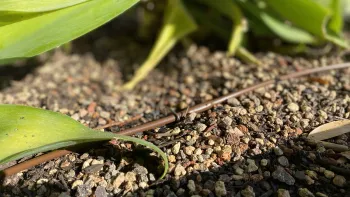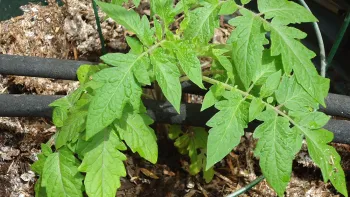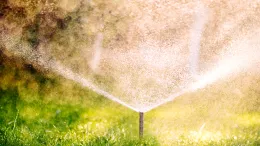Types of Irrigation Systems
The most effective irrigation systems are designed, installed, and maintained to distribute water as uniformly as possible – and only when and where water is needed. That means applying water where roots can use it. There are many different devices you can use for watering – from watering cans to hose end sprayers, sprinklers, soaker hoses, and drip lines. Each has its own strengths and weaknesses.
Hand watering: keep it accessible
Even in gardens with elaborate irrigation systems, there is always a time and place to grab a hose or watering can. This allows you to provide quick, easy, directed moisture to specific plants, particularly for small areas and containers.

Garden hose
Attach a hose-end shutoff nozzle on all hoses to reduce wasted water. Your local water district may provide these nozzles free of charge. Learn more about water conservation rebates and incentives.
- Choose the appropriate length for your space. Hoses that are too long or too short lead to frustration.
- Purchase durable hoses that are less likely to kink. Rubber is a good choice.
- Use brass couplings for connecting hoses to spigots.

Watering can
To avoid strained hands or backs, avoid cans that are too large or too heavy when filled with water.
Drip irrigation: best choice for conserving water
Drip irrigation works by placing water slowly and directly into the soil—literally “dripping” it in from the many small water emitters which are placed one or more at each plant, or emitter line which is snaked around the planted bed. Drip is excellent for watering sloped gardens because the slow rate of water applied through drip irrigation means it is more likely to soak in before it runs off.
Drip irrigation is the most efficient, water-saving method.

A drip system is the most water-conserving irrigation method available. While involving some time, effort, and cost, a properly designed and installed drip irrigation system saves considerable water and money, and makes the job of watering the garden easier. Drip irrigation works by placing water slowly and directly into the soil—literally “dripping” it in from small water emitters placed one or more at each plant, or emitter line in which the emitters are built-in along the tubing.
Pros
- Efficient – Drip systems are by far the most efficient irrigation method because water is applied precisely where it's needed.
- Eliminates runoff, evaporation, and erosion
- Good for all soil types – Slow delivery of water over an extended length of time prevents runoff on clay soils and helps keep sandy soil from drying out.
- Good for windy areas – Water is dripped directly into soil, not into the air.
- Good for hillsides – The slow rate of water applied means it is more likely to soak in before it runs off.
- Makes watering easy – An irrigation controller makes it easy to set or change the correct irrigation frequency and duration.
- Encourages root growth
- Flexible – Drip systems work in a variety of landscapes and can be altered and changed as plants grow.
- Helps reduce weeds – Weeds are less problematic when they aren't watered.
- Saves money – By saving water, you'll also save money.
Cons
- Not visible under mulch
- Requires routine maintenance for clogged or dislodged emitters.
- Potential damage by shovels or rodents – Some pets enjoy chewing on drip tubing.
- You may not know there's a problem until your plant(s) show signs of distress. ("Smart" controllers and flow meters reduce this problem.)
General rules of thumb for drip irrigation
- Drip tubing (half-inch or five-eighths-inch diameter) should not exceed 400 feet long on one valve (also called a "zone").
- Do not exceed 200 1-gallon per hour (gph) emitters in one zone.
- Avoid "spaghetti tubing" (one-eighth-inch or one-quarter-inch diameter) longer than 8 feet.
- For larger landscapes and vegetable gardens, consider in-line drip tubing (half-inch or five-eighths-inch diameter). With in-line drip there are no protruding emitters that can break off. In-line drip tubing is available with emitters at 6-inch, 12-inch, 18-inch, or 24-inch intervals.
Soaker hose: easy, but not as accurate or water-conserving as drip

A soaker hose is made of porous material that slowly allows water to seep out along the length of the hose. Similar to a soaker hose is drip tape, a more lightweight product that works for row crops and raised beds.
Pros
- Easy and inexpensive – Simply attach to a garden spigot.
- Useful for small gardens – good alternative when drip is not a possibility.
Cons
- Uneven and inconsistent watering because the holes are not precise. On hillsides, more water is delivered at the downhill end of the hose.
- Water goes to unintended areas in beds with widely spaced plants. You end up watering the empty spaces (or weeds) in between.
- Hoses wear out – Some only last a season or two, as minerals in water easily clog the holes.
- Difficult in irregularly shaped gardens – Soaker hoses are most useful where plants are grown in narrow, straight rows.
Spray systems: still the standard for lawns
Overhead watering with sprays (sprinklers) is a much less efficient way of putting water where plant roots will effectively use it. However, it is still the standard choice for lawns.
Hose-end sprinkler

A hose-end sprinkler is good for watering seed beds but it’s best to switch to a soaker hose or drip line as plants grow. Watering with a sprinkler wets the plants leaves, which makes many plants more susceptible to diseases, encourages slugs and snails, and wastes water.
Automatic sprinkler systems

Spray systems are generally used for lawns. Fixed or rotary heads are increasingly efficient when installed in a uniform layout.
Pros
- Good for lawns, so long as the coverage is even. (In-line drip tubing can also be used for lawns.)
- Can easily see how the system is working
- Improvements being made – Some multi-stream rotator nozzles and high-efficiency nozzles are much more efficient than conventional nozzles. Check your local irrigation supply store to learn about your options.
Cons
- Wastes water – Controlling misting and evaporation requires careful installation and adjustment.
- Hard to control runoff and erosion
- Upkeep – Nozzles, spray heads, and other parts get clogged or broken and must be monitored, repaired, and replaced.
- Spray heads become blocked as plants grow
- Encourages weeds – It's difficult to control exactly what you're watering.
- Not good for windy areas – Watering on windy days results in misting.
- Not good for heavy clay soil – Water may runoff instead of soaking into soil.
- Can encourage foliar diseases – Spray wets plant leaves, which makes many plants more susceptible to diseases and encourages slugs and snails.
- Can create slippery situations when water is inadvertently applied to patios, brick paths, sidewalks, etc.
- Higher water bills – More water used means more money spent.
Test your lawn sprays
One of the key measures of a spray system's effectiveness is even distribution of water. Here's how to find out if your lawn is being watered evenly:
- Place a few empty tuna cans randomly around your lawn.
- Run your sprinklers for 15 minutes.
- Measure the depth of the water in each can. Cans with more water may be over-sprayed.
- Adjust spray nozzles as needed.
Professional help with a qualified water efficient landscaper

If you are considering hiring a professional to assist with your irrigation plans, inquire about QWEL (Qualified Water Efficient Landscaper) certification. QWEL is a program of the Sonoma-Marin Saving Water Partnership. The Qualified Water Efficient Landscaper training presents an affordable, proactive, local approach to reducing landscape water demand. QWEL provides graduates with knowledge in water efficient and sustainable landscape practices, including water management and preservation of other valuable resources.
> BACK TO BASICS
> IRRIGATION
> Irrigation: How to, How Much
> Water Saving Tips for Your Garden
> Invite a Master Gardener to Your Garden

